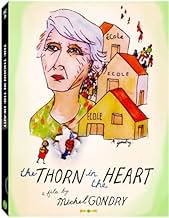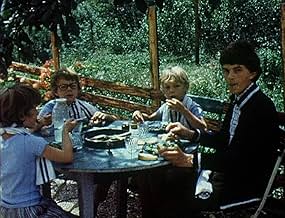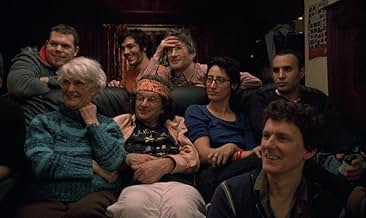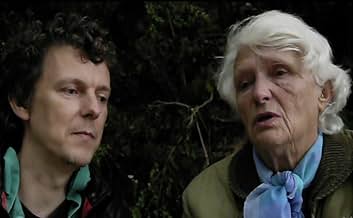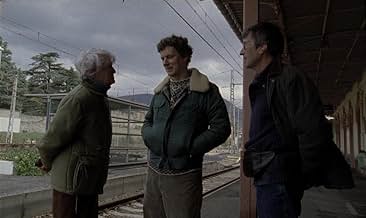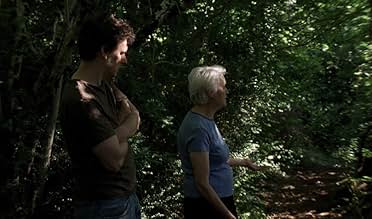Agrega una trama en tu idiomaMichel Gondry chronicles the life of Gondry family matriarch, his aunt Suzette Gondry, and her relationship with her son, Jean-Yves.Michel Gondry chronicles the life of Gondry family matriarch, his aunt Suzette Gondry, and her relationship with her son, Jean-Yves.Michel Gondry chronicles the life of Gondry family matriarch, his aunt Suzette Gondry, and her relationship with her son, Jean-Yves.
- Premios
- 2 nominaciones en total
- Dirección
- Guionista
- Todo el elenco y el equipo
- Producción, taquilla y más en IMDbPro
Opiniones destacadas
Just saw this film in NYC, there was also a Q&A after with the man himself after.
I found the film to be a beautiful portrait of someone's life, and how the people around them are affected. Michel said in the Q&A that he wanted to give his Aunt some visual record/history of her life, and this film goes to show that you don't need to create a Hollywood fictional character, real people are just as interesting and entertaining. Gondry uses a mixture of visual formats to illustrate the documentary, from super 8 to his well known stop motion. This adds a richness, and a historical depth that works within the context of the film. The film is emotionally moving at times and also humorous. The film is simple and enjoyable, one that does not need to be taken too seriously, yet carries tones of a maturity in Gondry's work that is often not always so prominent.
Go see it!
I found the film to be a beautiful portrait of someone's life, and how the people around them are affected. Michel said in the Q&A that he wanted to give his Aunt some visual record/history of her life, and this film goes to show that you don't need to create a Hollywood fictional character, real people are just as interesting and entertaining. Gondry uses a mixture of visual formats to illustrate the documentary, from super 8 to his well known stop motion. This adds a richness, and a historical depth that works within the context of the film. The film is emotionally moving at times and also humorous. The film is simple and enjoyable, one that does not need to be taken too seriously, yet carries tones of a maturity in Gondry's work that is often not always so prominent.
Go see it!
What? No Gondrys on IMDb today? Well then I guess the rest of us can pack up and go home. Forgive me for being insensitive to cinematic master Michel Gondry's cherished family memories, but I'm going to have some fun slamming this film. Why? Because if nothing else, I don't want my review to bore you as much as "The Thorn in the Heart" bored me.
Seriously I could only take about 40 minutes, and even that was because my dog was lying on the remote so I couldn't shut it off.
All kidding aside, before I start I'd like to quote something said by the late, great Stanley Kubrick when asked if he used LSD to get his uniquely bizarre ideas. He answered, "No. I believe that drugs are basically of more use to the audience than to the artist ... One of the things that's turned me against LSD is that all the people I know who use it have a peculiar inability to distinguish between things that are really interesting and stimulating and things that appear so in the state of universal bliss the drug induces on a good trip." (Agel, The Making of Kubrick's 2001, 1970, excerpted from the Playboy interview, p. 346)
"The Thorn in the Heart" is about Suzette Gondry, Michel's aunt. Now I would say that Michel obviously finds that subject to be really interesting. However, I submit that his subjective and emotional involvement with his aunt severely compromised his "ability to distinguish between things that are really interesting and things that appear so in a state of universal bliss." Whether LSD was involved is a different matter.
The film opens with a scene around the dinner table of about 12. No one is introduced, we're just supposed to piece together who's who (incidentally, the whole documentary is shot this way... fine for family albums but not so easy for us outsiders to follow). The woman referred to as Suzette chimes in with a story. It goes on for a painfully long time because she keeps breaking into laughter in mid sentence, getting more and more hysterical with her unfinished story until the others at the table literally begin a different conversation, something about vomits and farts (I'm not kidding). Suzette eventually finishes the anecdote, but by this time everything has dragged on so long that nobody, least of all the audience, gets the point. Literally, a few people ask her to repeat the punchline. "He could've had what? ...Oh, sauerkraut? Oh haha," they laugh languidly. Sure, to the Gondry family it's an endearing moment. But to us, meeting someone for the first time and sitting through this, it's slightly aggravating. And believe it or not, that opening scene was the most eventful scene in the 40 minutes I sat watching, while carefully trying to roll my dog off the remote so not to disturb her sleep, which seemed far more enjoyable than my experience on the couch.
I feel like the documentary could have benefited tremendously from an objective co-director, someone who could politely tell Michel that people don't understand inside jokes of strangers. And instead of putting the film together in a dry, historical way (chronologically beginning at 1954 and progressing year by year by year), the objective editor might have suggested to begin with something sensational and dramatic, the way even famous biopics are structured so that the audience is given a reason to invest their time watching.
Is this a bad film? Certainly not. I do distinguish between 'bad' and 'boring' (often they are not synonymous). But for me, this film conjured up nightmarish memories of the times I would end up at a stranger's party, not knowing a soul, not understanding all their inside jokes, and growing more awkward and agoraphobic by the minute. I no longer go to strangers' parties, wisely. And I think I'll make it a rule that I'll no longer watch strangers' home movies. "Voyeuristic" is a word used by another reviewer, and I now understand what was meant by it. To the Gondry family, I'm genuinely happy that you have this excellent way of preserving your cherished family memories. With all due respect, I'll just put this DVD back where I found it, as if I had accidentally bumped a priceless heirloom I had no business bumping.
So if you decide to watch, be ready to accept that the Gondry family is important enough to spend 84 minutes learning about. Devoid of Michel's usual creative visuals and surrealistic storytelling, this film is a very flat documentary. If the subject doesn't immediately entice you, then you're outta luck. Unless of course you manage to drop a tab beforehand.
Seriously I could only take about 40 minutes, and even that was because my dog was lying on the remote so I couldn't shut it off.
All kidding aside, before I start I'd like to quote something said by the late, great Stanley Kubrick when asked if he used LSD to get his uniquely bizarre ideas. He answered, "No. I believe that drugs are basically of more use to the audience than to the artist ... One of the things that's turned me against LSD is that all the people I know who use it have a peculiar inability to distinguish between things that are really interesting and stimulating and things that appear so in the state of universal bliss the drug induces on a good trip." (Agel, The Making of Kubrick's 2001, 1970, excerpted from the Playboy interview, p. 346)
"The Thorn in the Heart" is about Suzette Gondry, Michel's aunt. Now I would say that Michel obviously finds that subject to be really interesting. However, I submit that his subjective and emotional involvement with his aunt severely compromised his "ability to distinguish between things that are really interesting and things that appear so in a state of universal bliss." Whether LSD was involved is a different matter.
The film opens with a scene around the dinner table of about 12. No one is introduced, we're just supposed to piece together who's who (incidentally, the whole documentary is shot this way... fine for family albums but not so easy for us outsiders to follow). The woman referred to as Suzette chimes in with a story. It goes on for a painfully long time because she keeps breaking into laughter in mid sentence, getting more and more hysterical with her unfinished story until the others at the table literally begin a different conversation, something about vomits and farts (I'm not kidding). Suzette eventually finishes the anecdote, but by this time everything has dragged on so long that nobody, least of all the audience, gets the point. Literally, a few people ask her to repeat the punchline. "He could've had what? ...Oh, sauerkraut? Oh haha," they laugh languidly. Sure, to the Gondry family it's an endearing moment. But to us, meeting someone for the first time and sitting through this, it's slightly aggravating. And believe it or not, that opening scene was the most eventful scene in the 40 minutes I sat watching, while carefully trying to roll my dog off the remote so not to disturb her sleep, which seemed far more enjoyable than my experience on the couch.
I feel like the documentary could have benefited tremendously from an objective co-director, someone who could politely tell Michel that people don't understand inside jokes of strangers. And instead of putting the film together in a dry, historical way (chronologically beginning at 1954 and progressing year by year by year), the objective editor might have suggested to begin with something sensational and dramatic, the way even famous biopics are structured so that the audience is given a reason to invest their time watching.
Is this a bad film? Certainly not. I do distinguish between 'bad' and 'boring' (often they are not synonymous). But for me, this film conjured up nightmarish memories of the times I would end up at a stranger's party, not knowing a soul, not understanding all their inside jokes, and growing more awkward and agoraphobic by the minute. I no longer go to strangers' parties, wisely. And I think I'll make it a rule that I'll no longer watch strangers' home movies. "Voyeuristic" is a word used by another reviewer, and I now understand what was meant by it. To the Gondry family, I'm genuinely happy that you have this excellent way of preserving your cherished family memories. With all due respect, I'll just put this DVD back where I found it, as if I had accidentally bumped a priceless heirloom I had no business bumping.
So if you decide to watch, be ready to accept that the Gondry family is important enough to spend 84 minutes learning about. Devoid of Michel's usual creative visuals and surrealistic storytelling, this film is a very flat documentary. If the subject doesn't immediately entice you, then you're outta luck. Unless of course you manage to drop a tab beforehand.
1st things 1st : do not expect classic gondry's work. This is much different, in a personal way, a project he did finance himself, far away from any major studios. Back to his roots, family, Gondry films his ant and cousin. They share few secrets from the past which will come back because of the camera they have to deal with ; obviously, the camera that Gondry is using. Because it's a documentary about family, Gondry had all the confidence from his ant and cousin he could go and film them and picture the details and secrets they are having/sharing/hiding. It is very human, lot of scenes in the nature. I think Gondry needed to do this film for maybe his family but for him too, so he could remember where he is coming from (which I am sure he never forget) and do the most personal work ever.
Michael Gondry, renowned for his visual escapism and audacious visuals, brings us a sombre, almost exclusively down-to-earth low key picture of the life and times of a section of the Gondry family. Focused primarily on his Aunt Suzette, a retired school-teacher is a secluded village district, Gondry subtly paints a picture of an ordinary family and its trials and tribulations. Save for the odd bits of quirky animation, a train-set functioning as a time device and a bit of cinematic fun with invisible children, Gondry goes full frontal bare minimum on us, largely escaping more inventive cinematography, instead for a more sombre, albeit simultaneously ecstatic presentation of tidbits of family history.
Aunt Suzette is an endearing person, as is her somewhat estranged, even resentful, son Jean Yves. Firmly on their shoulders the almost prosaic movie does delivers moments of restrained satisfaction, much like peeking at home movies of your neighbours. Venturing a bit through time and touching on some grinding internal family issues, Gondry's documentary is a slight odd ode to the Gondry clan, which at times feels too personal to actually be suited for a publicly attainable feature. The movie even features significant snippets of private collections of 16mm home-made movies, which, largely unedited, imprint an even more voyeuristic feel to the viewing. By the end credits I did come to like the family, and even developed an affinity for the warm demeanour of Michael Gondry himself. Suzette as well as draws you in and surprises with small tidbits of prolific wisdom as well as her heartfelt remembrance of days past. This is probably the type of movie most of us would dream of doing - a summary of a life of someone dear to you kept forever on celluloid.
Aunt Suzette is an endearing person, as is her somewhat estranged, even resentful, son Jean Yves. Firmly on their shoulders the almost prosaic movie does delivers moments of restrained satisfaction, much like peeking at home movies of your neighbours. Venturing a bit through time and touching on some grinding internal family issues, Gondry's documentary is a slight odd ode to the Gondry clan, which at times feels too personal to actually be suited for a publicly attainable feature. The movie even features significant snippets of private collections of 16mm home-made movies, which, largely unedited, imprint an even more voyeuristic feel to the viewing. By the end credits I did come to like the family, and even developed an affinity for the warm demeanour of Michael Gondry himself. Suzette as well as draws you in and surprises with small tidbits of prolific wisdom as well as her heartfelt remembrance of days past. This is probably the type of movie most of us would dream of doing - a summary of a life of someone dear to you kept forever on celluloid.
I was able to see this movie at SXSW this year, and I'm grateful that I had that privilege.
I really enjoy being able to look into a stranger's life and just learn random tidbits that would otherwise remain unknown. Being able to see the life of Suzette Gondry was very interesting. The film seemed like a personal movie that Michel made just for him and his family, but it was neat being able to watch this film and feel as if you're being welcomed into their lives--if even just a small part.
After learning about all the ups and downs of her life and watching the impact she has had on many people, I felt as if Suzette had been a part of my life.
I really enjoy being able to look into a stranger's life and just learn random tidbits that would otherwise remain unknown. Being able to see the life of Suzette Gondry was very interesting. The film seemed like a personal movie that Michel made just for him and his family, but it was neat being able to watch this film and feel as if you're being welcomed into their lives--if even just a small part.
After learning about all the ups and downs of her life and watching the impact she has had on many people, I felt as if Suzette had been a part of my life.
¿Sabías que…?
- ConexionesEdited from Aguas borrascosas (1941)
Selecciones populares
Inicia sesión para calificar y agrega a la lista de videos para obtener recomendaciones personalizadas
Detalles
- Fecha de lanzamiento
- País de origen
- Idioma
- También se conoce como
- The Thorn in the Heart
- Productoras
- Ver más créditos de la compañía en IMDbPro
Taquilla
- Total en EE. UU. y Canadá
- USD 7,376
- Fin de semana de estreno en EE. UU. y Canadá
- USD 5,173
- 4 abr 2010
- Total a nivel mundial
- USD 17,849
- Tiempo de ejecución1 hora 26 minutos
- Color
Contribuir a esta página
Sugiere una edición o agrega el contenido que falta

Principales brechas de datos
By what name was L'épine dans le coeur (2009) officially released in Canada in English?
Responda

